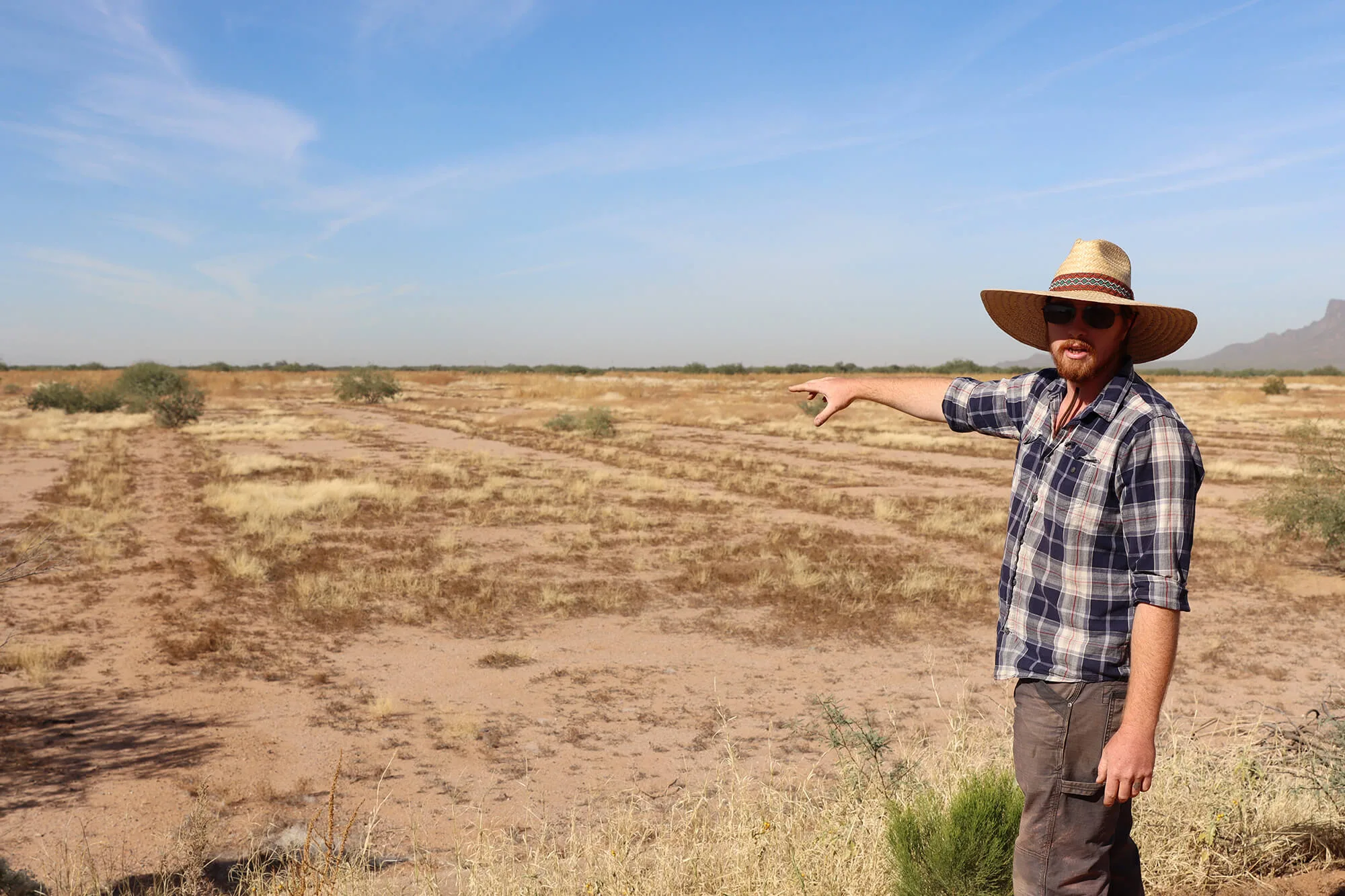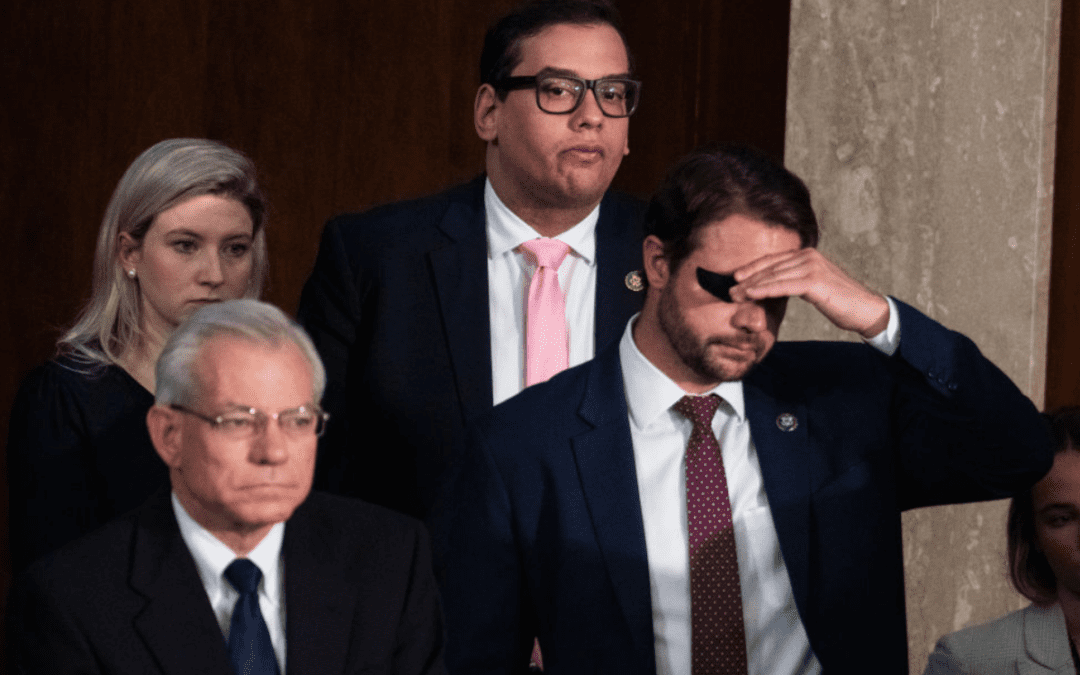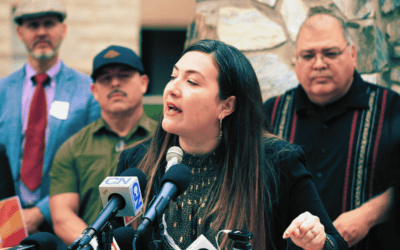
(Photo by Brock Blasdell/Cronkite News)
All around Picacho Peak, the Sonoran Desert is brown and dry and rough. The soles of your feet could not tell the desert hardpan from an asphalt road.
About 2,500 feet above the ground, water vapor streaming northeast into Arizona from the Gulf of California condenses into larger and larger droplets until they’re too heavy to remain suspended. When thousands become one, that drop falls toward earth. For two to seven minutes, the drop freefalls, reaching speeds up to 20 mph before it strikes the surface.
The impact is quiet. But for the compacted soil, the rain does not provide necessary moisture, it tears the land apart. The crust on top of the soil keeps the water from penetrating. As the water seeks its level, it rips across the surface in muddy flash floods, further eroding topsoil.
On an 8-acre plot off South Aguirre Lane in unincorporated Red Rock, Ricardo Aguirre is using his family’s old ranch to prove there is a way to stop the flooding and erosion. He can’t make the rain fall, but his mission is to prepare the land to utilize the rain when it comes, “making sure every raindrop is effective the moment it falls on the ground,” said Aguirre, a drainage engineer.
“Which means get it in the ground and make sure that it doesn’t run laterally across.”
Aguirre directs land management and water security for the civil engineering firm WEST Consultants Inc., which specializes in water resource management and has offices in Arizona, California, Oregon, Washington, and Texas. The land where his family once farmed cotton and ran cattle is where he now demonstrates methods to restore grasslands, improve soil health and ultimately reverse desertification.
Deserts cover more than 41% of Earth’s landmass, according to the United Nations. But because of human activity, deserts are growing by about 33,000 square miles – the size of Ireland – every year.
Deforestation, destructive agricultural practices, and climate change have contributed to the degradation of topsoil and expanding deserts. Yet healthy topsoil is essential to growing food, and according to one U.N. study, if land degradation continues, topsoil could be gone within 60 years.
The symptom of desertification that Aguirre is addressing is excess flooding. He’s looking at alternative land management practices to return water cycles to nature’s designs.

Going against the grain
Aguirre spent more than a decade of his civil engineering career utilizing modern methods of stormwater management. His textbooks and his degree from University of Illinois taught him to manage water with a pipe, a channel, and a hole in the ground. He described his career as “intrinsically connected to the land,” and that connection, along with his agrarian roots, led to much deliberation in the back of his mind. He felt a responsibility to leave the land he worked with better than he found it.
In August 2010, he became a father, and those deliberations moved to the front of his mind.
Aguirre imagined a conversation 15 years in the future in which his son asks whether he took advantage of being in a position to do something about the degrading environment.
“Looking at the designs that I had, that are now constructed, and the impact that they have on the environment,” Aguirre said, “I didn’t like the answers that I was giving … for that conversation with my son.”
Aguirre relegated his textbook knowledge and looked to a different teacher: Mother Nature. He studied how nature configured the water cycle, and how humans used to exist in and be part of the mineral cycles, eating and drinking off the land and returning the nutrients as wild animals do today, before the industrial revolution began in the 1700s.
“So through that discovery, I realized that we are going 180 degrees against the grain,” Aguirre said. “And the harder that we fight nature’s principles, the more degradation that we’re creating.”
In his research, Aguirre discovered holistic land management, which uses controlled grazing techniques to work cooperatively with ecosystem processes. It was pioneered by Allan Savory, founder of the Savory Institute, who grew up in South Africa loving the environment and despising livestock because he believed grazing damaged the land.
As a young biologist in Africa, he worked to set aside land to become national parks. In the 1950s, the protected land he studied in Zimbabwe continued to deteriorate, and he concluded there were too many elephants for the land to sustain. His superiors confirmed his research.
“Over the following years, we shot and killed 40,000 elephants to try to stop the damage,” Savory said in a 2013 TED Talk. “And it got worse, not better.”
He described it as “the saddest, and biggest blunder” of his life.
Savory was determined to find solutions. He traveled to the western US, where cattle had been removed from land to demonstrate how that would stop desertification. But he said he found the opposite.
Savory came to understand that the vegetation being lost in these expanding deserts was developed over thousands of years and adapted to large herds of grazing animals migrating across the landscape.
Aguirre is trying to address these same issues in the Southwest, explaining that land degradation has been caused by the lack of migratory animals brought on by urban expansion that reduces and limits animal populations.
When a fence goes up, said Grant Tims, Aguirre’s ranch manager, the land is left idle.
“So in arid climates, it’s the rest that is the problem,” Aguirre said, as Savory witnessed in Africa. “Where most people think it’s overgrazing.”
Aguirre relates “the health of the land to the health of the human body,” comparing land degradation to muscle atrophy in people: A sedentary lifestyle will cause the body to deteriorate.
“You’re not stressing the land with hoof action, you’re not stressing the land with animal impact,” he said. “That stress will actually cause a positive response.”
Aguirre reached out to the Savory Institute after the 2013 TED talk with a new concept of connecting civil engineering and holistic land management. In 2014, he went to Zimbabwe to see Savory’s work for himself.
Aguirre visited a small stream with big implications. The stream in recent decades had been ephemeral, meaning it only runs after rains, but villagers in the area had transformed the stream through holistic land management.
“For me, as a drainage engineer,” Aguirre said, “that just blew my mind that seven out of nine villagers that subscribed to this program were able to restore the watershed function to the degree that the streams were running again, on a perennial level, and reversed 40 years of an ephemeral stream.”
Shortly after, Aguirre became the director of his own Savory Hub in Arizona, which now is called the Drylands Alliance for Addressing Water Needs, where he teaches holistic land management practices. His goal is to transform his desertifying homeland, halfway between Phoenix and Tucson.
“That’s … my personal BHAG (big hairy audacious goal) as a drainage engineer is to get that level of watershed function back into the watersheds of Arizona and the Southwest and beyond,” he said.
Aguirre took the idea of using land management instead of concrete and steel to address water resources to WEST Consultants, which welcomed the idea.

How a watershed works
A watershed is an area of land that “channels rainfall and snowmelt to creeks, rivers and lakes” according to the National Ocean Service.
“If you look at a leaf,” Aguirre said, “a leaf pattern shows that. Because that’s how nature has figured out how to get nutrients.” Or like the human body, he added, with a system of veins leading to the heart.
Ideally, most rain will seep into the soil, recharging the aquifers and moving through the soil toward a common body of water.
When raindrops fall onto land where watershed function is deteriorating because of desertification, it runs off.
“It begins to make one, two, three, four one-off tributary streams,” Aguirre said. Those ephemeral streams lead to extensive erosion, which destroys roads and bridges as well as topsoil.
“A functioning watershed should really only have one, maybe two tributaries,” he said.
The remedy, Aguirre believes, is to restore vegetation and root systems to the barren soil.
Erinanne Saffell, Arizona’s state climatologist, described the important role of plants in the hydrologic cycle.
“We want to have what’s called interception,” she said, “which is where the precipitation will hit trees, vegetation of some kind … that allows the water to infiltrate more readily and recharge our aquifers.”
Vegetation acts as “storage locations and transfer mechanisms of water,” Saffel said. “If (raindrops) come down and hit bare soil, that’s actually very disruptive to having water go into the ground and recharge our aquifers.”
Water security concerns continue to loom in Arizona, where heavy monsoon rains in 2021 did little to alleviate long-term drought conditions, according to the Arizona Department of Water Resources. Arizona is still experiencing severe drought or worse this year.
Aguirre is preparing the land on his demonstration site to better receive rain to revitalize the grasslands, which are now bare, but under the soil lie seeds hungry for water.
“What we can expect is that there is a seed bank, roughly about 2,000 seeds waiting to be germinated in every square yard,” Aguirre said. “It’s just a matter of assembling the right conditions for that germination.”

Soil intervention
Like a human body that has spent years resting, failing to get proper nutrition and not drinking enough water, the desert needs help, Aguirre said.
The health services Aguirre and Tims provide are moving sheep, goats, and chickens across the demonstration site; their hooves break up the hard soil and their dung and urine fertilize it for weeks at a time.
To accelerate the regeneration process, Aguirre and Tims also use what they call biological soil amendments, made up of bacteria, fungi, and other microbes. The increase in this carbon-based matter helps provide nutrients to plants and boost the soil’s ability to absorb and hold water.
When Aguirre returned to the property he grew up on in the summer of 2019, “we started with basically bare soil,” he said. Now, especially after heavy monsoon storms in 2021, there is growing evidence that the land is responding positively to the animals, in some places the evidence is as tall as him.
“The grasses where the animals have been have been beyond waist high, compared to where the animals have not been, are barely coming up to a person’s knees,” Aguirre said.
On a tour last fall of the site, Tims lifted a blue tarp off a compost pile used to brew the biological soil amendments. Unlike the surrounding landscape, the little world under the blue tarp is teeming with life that flies, jumps or scurries away as the tarp is removed.
Aguirre and Tims steep the compost like a tea bag, extracting the abundance of microbial life.
“We take that water and put it in a brewer, and that’s what we’re actually putting into the soil,” Tims said. Using a low-impact plow with circular blades, the brew soaks into soil, priming the pump for seed germination.

The lungs of the land
Revitalizing grasslands in desertified regions does more than improve watershed function, it allows the soil to breathe in and trap carbon – making it a natural countermeasure to the rising carbon dioxide levels contributing to climate change, according to the US Department of Agriculture.
Healthy vegetation sequesters carbon through photosynthesis, pumping it down through its roots and into the soil. The healthier the soil, the deeper the carbon may go.
Pawlock Dass, with the department of land, air, and water resources at the University of California, Davis, co-authored a 2018 study that shows grasslands are an even more reliable carbon sink than trees, particularly because of the increasing threat of wildfire.
Dass said healthy forests store more carbon than grasslands, but there’s a catch in California, Arizona, and other arid places.
“Forests store a large percentage of their carbon above ground, that is the bulk of the tree biomass, that is a trunk of a tree,” Dass said, and in a wildfire, all that carbon is released into the atmosphere.
Grasslands, however, store most of their carbon below ground as root biomass, he said, where it’s protected from fires and promotes healthy soil that allows grasslands to grow back.
Dass’ study looked specifically at companies investing in planting forests to offset carbon emissions.
“If that carbon gets emitted back into the atmosphere (in a fire), it doesn’t really make much sense,” Dass said. “All the investment is basically lost.”
Restoring the cycle
When a raindrop strikes areas of revitalized grass off South Aguirre Lane, it doesn’t tear the land apart. It gets captured by the vegetation and transferred into the soil. The root systems and growing microbial populations absorb and hold the water – promoting more grass growth and more water capture. Eventually, it seeps down to recharge the aquifers.
“We can’t make it rain, but what we can do is we can make the rainfall more effective,” Aguirre said. “We’re offering land management as an alternative to engineering.”
The process starts in the lab, where Aguirre and Tims inspect the bacterial and fungal population of the compost through a microscope. The microbiology helps germinate the seeds in the soil, the grass then is grazed by chickens, sheep, and cows that further break up the soil. More water is absorbed, which means more grass, more animals, more life.
The objective is to counteract desertification and its symptoms.
“All of (the problems) come back to this,” Tims said. “Compaction and biology.”
It turns deserted land into a valuable, fertile asset. It restores watershed function, helping with water security concerns, according to Aguirre and Tims.
Don Steuter, with the Sierra Club’s Grand Canyon Chapter, which has been critical of Allan Savory’s cattle grazing claims in the past, expressed cautious optimism about Aguirre’s undertaking.
“We’re always interested in projects like this,” Steuter said, although he believes the success of cattle-grazed land is more likely to be a site-specific fix rather than a universal one.
“We’d be tickled to death if cattle could make the land better,” Steuter said. “It would solve a lot of our problems, but we don’t think it’s very likely.”
Still, Steuter said, he’s intrigued with Aguirre’s mission to heal watershed function and is looking forward to seeing the results.
Aguirre and WEST consultants are working on land restoration projects in Cochise County and are seeking state and federal contracts as well.
Aguirre said he’s the only civil engineer he knows of who’s bridging holistic land management with his profession. He hopes not for long.
“The overarching objective that I believe my calling is, is to reinvent my profession of civil engineering,” Aguirre said.
In three years, when his son turns 15, Aguirre can realize that imaginary conversation. If his son asks him if he used his position to improve the degrading environment, Aguirre no longer has to give the answer he never wanted to:
“I didn’t do anything about it.”
Looking for the latest Arizona news? Sign up for our FREE daily newsletter.

He said what? 10 things to know about RFK Jr.
The Kennedy family has long been considered “Democratic royalty.” But Robert F. Kennedy, Jr.—son of Robert F. Kennedy, who was assassinated while...

Here’s everything you need to know about this month’s Mercury retrograde
Does everything in your life feel a little more chaotic than usual? Or do you feel like misunderstandings are cropping up more frequently than they...

Arizona expects to be back at the center of election attacks. Its officials are going on offense
Republican Richer and Democrat Fontes are taking more aggressive steps than ever to rebuild trust with voters, knock down disinformation, and...

George Santos’ former treasurer running attack ads in Arizona with Dem-sounding PAC name
An unregistered, Republican-run political action committee from Texas with a deceptively Democratic name and ties to disgraced US Rep. George Santos...




